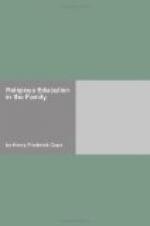The child is a playing animal. Play is not an invention of the devil, designed to plague parents and to lead children to waste their time. It is nature’s best method of education, for when a child plays he is simply reaching forward in his activities to the realization of his ideals. Play is idealized experiences. There is always a significance of wider and maturer experience in children’s play. Therefore the family must find space and time and adaptation of organization to the child’s need of spontaneous, free activity in play.
The special religious value of play lies in the fact that the child in his games is experimenting with life, learning its lessons; especially is he learning the art of living with other lives. It is our religious duty to see to it that our children become used to living in society by playing in social groups. Scarcely anyone is more to be pitied than the lonely child standing in the corner of the playground, able only to watch the games, because parental prohibition has already made him a solitary and unsocial creature.
The educational potencies of play are so great that we dare not leave its activities to chance. Parents must study the power of play, its psychological and educational values, in order to direct its activity to the highest good.
The adequate care of a child’s play-life will involve, in addition to the trained intelligence of the parents, provision for space in the house and also outdoors, willingness to subordinate our peace and our pleasure to the child’s play at times, a reasonable though not necessarily expensive provision of play materials, attention to the character of the plays and playmates. The home will not lose its harmony and beauty if it is filled with playing children. Its function has to do with their development rather than with the preservation of chairs.
I. References for Study
H.F. Cope, Hymns You Ought to Know, Introduction. Revell, $1.50.
W.F. Pratt, Musical Ministries. Revell, $1.00.
H.W. Hulbert, The
Church and Her Children, chap. x. Revell,
$1.00.
II. Further Reading
For a list of great hymns see Hymns You Ought to Know, edited by Henry F. Cope, and mentioned above. It contains one hundred standard hymns with a brief account of each hymn and of each author.
E.D. Eaton, “Hymns
for Youth,” Religious Education, December,
1912, VII, 509.
See report of the Commission
on Worship in the Sunday School, in
Religious Education,
October, 1914.
Read especially the
chapter on this subject in H.H. Hartshorne,
Worship in the Sunday
School. Columbia University, $1.25.
III. Topics for Discussion
1. What special
advantages do songs and hymns have in their
pedagogical power?




